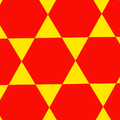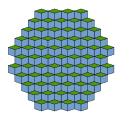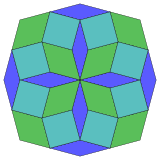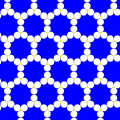User:Tomruen/Polytile

In geometry, a polytile is an equilateral polygon defines with specific angles. An n-tile is a polygon defined by an edge-to-edge cycle of regular n-gons. The vertices of the n-tile are positioned at the center of the n-gons.
A polytiling is a tessellation made from one or more polytiles from the set defined by the angles of a regular n-gon.
Polytile definition
[edit]
A polytile or p-tile as an equilateral polygon notated by a set of integers representing vertex angles. The p is an even whole number 4 or greater. The polytile angles representing multiples of a 360°/p degree turns. Angles are measured as turn angles, zero for straight (colinear edges), positive for counterclockwise turns, and negative for clockwise turns. For example: #Tetratiles, #Hexatiles, #Octatiles, #Decatiles, and #Dodecatiles have turn angles that are integer multiples of 90°, 60°, 45°, 36° and 30° turns respectively.
- A p-tile notational is: p:a1.a2…am^n. (A square is 4:1^4 as four quarter turns, 90°.)
- Each turn angle ai' index is an integer less than p/2. (Indices ±p/2 are half turns, 180°.)
- A ^n exponent repeats sequence n times. A chiral pair is mirrored as ^-n, including ^-1.
- The turning number is computed by: t=n(a1+a2+…+am)/p. If |t|=1, it is a simple polytile (convex or concave), otherwise, a star polytile.
- If the “p:” is not given, we assume simple (t=1), and compute p=n(a1+a2+…+am).
- Turn angles ai may be allowed outside (-p/2,p/2), but to correctly compute the turning number, they need be given within the signed range modulo p.
- A p-tile can be up-scaled: p:a1.a2..am^n to kp:ka1.ka2..kam^n, for any whole number k. In reverse, any kp-tile, with all indices as multiples of k, can be down-scale to a p-tile.
- A polytile expression that does not close as cycle is called a polychain.
A regular n-gon tile is represented by n 1's. The sum of these numbers equal n. For example 111111 or 1.1.1.1.1.1 or 16 is a regular hexagon, with 6 60° angles. Odd-sided regular polygons can only be generated by even, 2n-tiles. For example a triangle is 222 or 2.2.2 or 23, with 3 120° angles.
Zero indices can be given for collinear edges, and negative indices allow for concave, self-contacting and self-intersecting tiles. For example 1111 or 112 or 14 is a square, while a 2:1 rectangle is 110110 or 1102.
An exponent is always at the end, and applies to the full string of indices. A negative exponent can imply a reverse order for a chiral pair. For example 4321 = 1234-1.
A regular n-gon has r2n symmetry. For example a square is r8 symmetry.
Odd (2n+1)-tiles are only a subset of 2(2n+1)-tiles and are geometrically and notionally identical. For example, a hexagon is both 16 as a cycle of 6 hexagons, and 16 as a cycle of 6 triangles in alternating orientations.
Geometric interpretation
[edit]
Polytiles have a helpful geometric interpretation where each p-tile can be described by a cyclic path of regular p-gons connected edge-to-edge. The p-tile is constructed with its vertices centered on each regular p-gon of the cycle, with equal edges defined between adjacent p-gons.
Classifying and naming
[edit]A p-tile can be called a t-turn m-adic n-gram, with 3 parameters n, m, t:
- A polygram or n-gram, like monogram, digram, trigram, tetragram, pentagram, hexagram, etc. is any equilateral polygon with n-fold rotational symmetry.
- A polyad or m-ad, like monad, dyad, triad, tetrad, pentad, hexad, etc. as the number of vertices with its symmetry of a polygram.
- t-turn is the turning number. Crossed polygons, like a regular polygon with two vertices flipping places, can be a 0-turn which may be called counterturn. If we are interested in clockwise polygons, we can call them contra-t-turn.
An m-adic n-gram is an equilateral nm-gon. If m is 1, that qualifier can be suppressed.
Covers and compounds
[edit]A 4th parameter can be extracted, c-cover. If p:a1.a2…am^n is a valid polytile, then p:a1.a2…am^nc is a degenerate c-cover of it, repeating the same vertices and edges c times.
Multicovered polygons are degenerate and can’t be seen, but have a topological existence.
An ordinary interpretation of a c-cover regular polygon {ca/cb} factors out as c{a/b}, and draws it as a c-compound, adding rotated copies, giving ac-fold cyclic symmetry. This can be generalized for any polytile. A c-cover polytile, p:a1.a2…am^nc, is written as a c-compound c*p:a1.a2…am^n, interpreted as c rotated copies of p:a1.a2…am^n. A c-compound m-adic nc-gram has mnc vertices.
Shorter names for regular polygons (-are suffix)
[edit]Regular polygons (monadic, m=1) have no general specific names, except for the square. I propose we use the square as a guide, and use -are suffix for all regulars. An equilateral triangle becomes a trigram-are or triare for short. Regular polygons become: triare, tetrare, pentare, hexare, heptare, octare, etc.
Regular star polygons apply as well. A pentagram {5/2}, 2-turn monadic pentagram, becomes a 2-turn pentare. Generally, a regular {p/q} star polygon, p:q^p becomes a q-turn p-are.
Shorter names for isotoxal polygons (-us suffix)
[edit]An isotoxal or edge-transitive polygon (dyadic, m=2) has one edge type, 2 vertices within its symmetry. Polytile notation is: p:a.b^n. The smallest class are rhombi: p:a.b^2. Using the name rhombus as a standard, I propose a -us suffix. Then a rhombus is a digramus, or di-us for short. And in sequence: dius, trius, tetrus, pentus, etc.
Here we also find a new quality, convexity. The concave form will have one negative index, like p:-a.b^n (a, b positive). I differentiate as stella- prefix if concave and (optional) arch- prefix if convex, and lineo- if colinear edges. A concave isotoxal decagon can be called a stellapentus.
Shorter names for m-adic polygons
[edit]An m-adic n-gram can also be written as one word as n-gram-m-ad. An m-gon with no symmetry, a m-adic monogram, can be called a monogram-m-ad and mono-m-ad for short. An equilateral pentagon with no cyclic symmetry, a pentadic monogram, can be called a monogram-pentad and monopentad.
Number of convex tiles
[edit]A full set of convex polytiles represent all solutions for a given polygon. The numbers of forms are given below, chiral column counting chiral pairs. The number of tiles by sides are also given, with bold 1 given for regular polygon solutions.
Odd family polytiles, (2k+1)-tiles, are given for completeness. They are a subset of 2(2k-1)-tiles, identified with all odd-turn angle multipliers. The smallest odd solution is one triatile, with 6 triangles around a point, making a regular hexagon, and same as 6 hexagons for the first hexatile.
| 2n | Unique tiles |
With chirals |
Counts | |||||||||||||||||||||||||||||
|---|---|---|---|---|---|---|---|---|---|---|---|---|---|---|---|---|---|---|---|---|---|---|---|---|---|---|---|---|---|---|---|---|
| 3 | 4 | 5 | 6 | 7 | 8 | 9 | 10 | 11 | 12 | 13 | 14 | 15 | 16 | 17 | 18 | 19 | 20 | 21 | 22 | 23 | 24 | 25 | 26 | 27 | 28 | 29 | 30 | |||||
| 4 | 1 | 1 | 0 | 1+3 | ||||||||||||||||||||||||||||
| 6 | 3 | 3 | 1 | 1 | 0 | 1+1 | ||||||||||||||||||||||||||
| 3 | 1 | 1 | 0 | 1 | ||||||||||||||||||||||||||||
| 8 | 4 | 4 | 0 | 1+1 | 0 | 1 | 0 | 1 | ||||||||||||||||||||||||
| 10 | 7 | 7 | 0 | 2 | 1 | 2 | 0 | 1 | 0 | 1 | ||||||||||||||||||||||
| 5 | 2 | 2 | 0 | 1 | 0 | 1 | ||||||||||||||||||||||||||
| 12 | 16 | 17 | 1 | 1+2 | 1 | 1+3 | 1 | 3 | 1 | 1 | 0 | 1 | ||||||||||||||||||||
| 14 | 17 | 19 | 0 | 3 | 0 | 4 | 1 | 4 | 0 | 3 | 0 | 1 | 0 | 1 | ||||||||||||||||||
| 7 | 4 | 4 | 0 | 2 | 0 | 1 | 0 | 1 | ||||||||||||||||||||||||
| 16 | 28 | 34 | 0 | 1+3 | 0 | 5 | 0 | 1+7 | 0 | 5 | 0 | 4 | 0 | 1 | 0 | 1 | ||||||||||||||||
| 18 | 70 | 92 | 1 | 4 | 1 | 1+8 | 4 | 12 | 1+5 | 12 | 4 | 9 | 1 | 4 | 1 | 1 | 0 | 1 | ||||||||||||||
| 9 | 10 | 11 | 0 | 1+3 | 0 | 3 | 1 | 1 | 0 | 1 | ||||||||||||||||||||||
| 20 | 85 | 115 | 0 | 1+4 | 1 | 8 | 1 | 16 | 2 | 1+16 | 2 | 16 | 1 | 8 | 1 | 5 | 0 | 1 | 0 | 1 | ||||||||||||
| 22 | 125 | 187 | 0 | 5 | 0 | 10 | 0 | 20 | 0 | 26 | 1 | 26 | 0 | 20 | 0 | 10 | 0 | 5 | 0 | 1 | 0 | 1 | ||||||||||
| 11 | 15 | 18 | 0 | 4 | 0 | 5 | 0 | 4 | 0 | 1 | 0 | 1 | ||||||||||||||||||||
| 24 | 392 | 616 | 1 | 6 | 2 | 15 | 8 | 33 | 20 | 50 | 27 | 1+65 | 27 | 50 | 20 | 33 | 8 | 15 | 2 | 6 | 1 | 1 | 0 | 1 | ||||||||
| 26 | 379 | 631 | 0 | 6 | 0 | 14 | 0 | 35 | 0 | 57 | 0 | 76 | 1 | 76 | 0 | 57 | 0 | 35 | 0 | 14 | 0 | 6 | 0 | 1 | 0 | 1 | ||||||
| 13 | 30 | 40 | 0 | 5 | 0 | 10 | 0 | 8 | 0 | 5 | 0 | 1 | 0 | 1 | ||||||||||||||||||
| 28 | 704 | 1201 | 0 | 7 | 0 | 16 | 1 | 47 | 1 | 79 | 3 | 126 | 4 | 1+133 | 4 | 126 | 3 | 79 | 1 | 47 | 1 | 16 | 0 | 7 | 0 | 1 | 0 | 1 | ||||
| 30 | 3359 | 3359 | 1 | 7 | 1+2 | 1+23 | 17 | 71 | 60 | 1+172 | 145 | 329 | 249 | 442 | 1+314 | 442 | 249 | 329 | 145 | 173 | 60 | 71 | 17 | 24 | 3 | 7 | 1 | 1 | 0 | 1 | ||
| 15 | 82 | 116 | 0 | 9 | 0 | 1+17 | 5 | 21 | 3 | 15 | 2 | 6 | 1 | 1 | 0 | 1 | ||||||||||||||||
Tetratiles
[edit]
1111=14, r8
A tetratile only has turn angles of 90°. There is only one convex tetratile, the square itself. The only tiling is the square tiling.
Hexatiles
[edit] "Hexare" 16, r12 |
 Rhombus 212, d4 |
 "Triare" 23, r6 |
A hexatile uses turn angles of 60° and 120°. With 3 tiles, it is the smallest nontrivial set. The 3 tiles are: the regular hexagon 111111 or 16, the equilateral triangle 222 or 23, and 60 degree rhombus 1212 or (12)2. These are related to the rhombille tiling, and trihexagonal tiling.

|

|

|

|

|

|
Triatiles
[edit] Hexagon 16, r12 |
There is only 1 convex triatile, repeated as odd-only-indices from the hexatiles.

|
Octatiles
[edit] "Octare" 18, r16 |
 Hexagon 1212, i4 |
 Square 24, r8 |
 Rhombus 312, d4 |
An octatile has turn angles of 45°, 90° and 135°. There are 4 convex octatiles: the "octare" (11111111) or (18), Flatted hexagon (311211) or (311)3, and square (2222) or 24, and rhombus (4131) or (31)3.
The tiles are related to the Ammann-Beenker tiling which includes the square and rhombus. The chamfered square tiling is a simple tiling with the right hexagon.
 Square tiling |
 Truncated square tiling |
 Ammann-Beenker tiling |
 Chamfered square tiling |
Decatiles
[edit] "Decare" 110, r20 |
 Octagon 21112, d4 |
 Tall hexagon 2122, i4 |
 "Pentare" 25, r10 |
 Flat hexagon 1312, i4 |
 Rhombus 322, d4 |
 Rhombus 412, d4 |
A decatile has turn angles of 36°, 72°, 108°, and 144°. There are 7 convex decatiles: the regular decagon 11111111 or 110, octagon 21112111 or 21112, tall hexagon 221221 or 2212, and regular pentagon 22222 or 25, flat hexagon 113113 or 1132, wide rhombus 3232, or 322, and thin rhombus, 4141 or 412.
The penrose tiling contains the wide and narrow rhombus.
 Penrose tiling |
 Rhombille tiling |
 decagon-octagon-rhomb |
 pentagon-octagon-rhomb |
Pentatiles
[edit] Decagon 110, r20 |
 Flat hexagon 1312, i4 |
There are 2 convex pentatiles, repeated as odd-only-indices from the dodecatiles.

|
Dodecatiles
[edit] "Dodecare" 112, r24 |
 Decagon 112112, i4 |
 Enneagon 1213, i6 |
 Tall octagon 12212, p4 |
 Octagon 214, d4 |
 "Hexare" 26, r12 |
 Octagon 31112, d4 |
 Heptagon 2131131, i2 |
 Hexagon 3212 (a), g2 |
 Hexagon 3122 (b), g2 |
 "Trius" 313, d6 |
 Square 34, r8 |
 Flat hexagon 1412, i4 |
 Right pentagon 41331, i2 |
 Wide rhombus 422, d4 |
 "Triare" 43, r6 |
Thin rhombus 512, d4 |
A dodecatile has turn angles of 30°, 60°, 120°, and 150°.
There are 16 convex dodecatiles. The dodecatiles are used in pattern blocks, triangle, wide and narrow rhombs, square, and hexagon.
 Pattern blocks |

|
 Dissections of convex dodecatiles |
 2222 |
 1114 and 444 |
 2222 and 444 |
 444 |
 1412 |

|
 34 and 214 |
 34 and 11222 |
 34 and 11222 |
Tetradecatiles
[edit]There are 17 convex tetradecatiles, 19 with chiral pairs.
Heptatiles
[edit] Tetradecagon 114, r28 |
 Decagon 113112, i4 |
 Hexagon 3132, i4 |
 Hexagon 1512, i4 |
There are 4 convex heptatiles, repeated as odd-only-indices from the tetradecatiles.
Hexadecatiles
[edit]There are 28 convex hexadecatiles, 34 with chiral pairs.
Octadecatiles
[edit]There are 70 convex octadecatiles, 92 with chiral pairs.
Enneatiles
[edit]There are 10 convex enneatiles, 11 with chiral pairs, identical to the subset of octadecatile with only odd turn angle multiplers.
Icosatiles
[edit]There are 85 icosatiles, 115 including chiral pairs.
Icosiditiles
[edit]There are 125 convex icosiditiles, 187 with chiral pairs.
Hendecatiles
[edit]Icosihexatiles
[edit]There are 379 convex icosihexatiles, 631 with chiral pairs.
Tridecatiles
[edit]There are 30 tridecatiles, 40 with chiral pairs. They represent a subset of icosihexatiles with only odd turn angle multipliers.
Triacontatiles
[edit]There are 3359 convex triacontatiles, 3359 with chiral pairs.
Pentadecatiles
[edit]There are 82 convex pentadecatiles, 116 including chiral pairs. They represent a subset of tricontatiles with only odd turn angle multipliers.
Examples
[edit]Regular tiles
[edit]Each set of n-tiles has regular p-gon tiles for whole number divisors of n, 3 or larger.
Rhombic tiles
[edit]Rhombi are named as ab2, where a and b are positive integers, making a 2(a+b)-tile. A rhombus has d4 symmetry.
Elongated rhombic tiles
[edit]An elongated rhombus (hexagon) is named by aabaab or aba2, where a and b are positive integers, making a 2(2a+b)-tile. If a>b, it makes a short hexagon, and b>a makes a tall hexagon. An elongated rhombus has i4 symmetry.
Chiral zonogonal polytiles
[edit]
|

|
| The smallest chiral zonogon is a dodecatile, 1232 and 1322 | |
A chiral zongonal has 2-fold rotational symmetry, like a hexagonal one is abc2 where a,b,c are unique.















































































































































































































































































































































































































































































